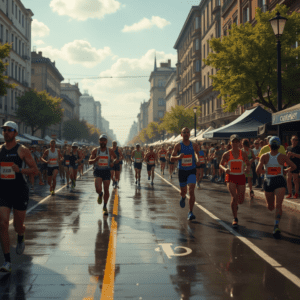If you are a road runner who wishes to run a major marathon, then you most likely have already heard statements like “I have three races to go before achieving the Mandala,” or “Running a Major is my wish.” The epitome of road running is the six Marathon Majors that capture top-caliber runners and hardcore amateurs worldwide.
This article will guide you through the qualification process, training to prepare for the challenge, and racing in these world-class events.
There are six internationally famous races that make up the World Marathon Majors:
The historic significance, impeccable planning, and chance to win the much coveted Six Star Medal (Mandala) by doing all six have made these races famous.

Evolution and History
The oldest of the majors is the Boston Marathon, which was founded in 1897. The other major races were established later to create the World Marathon Majors in 2006. By putting the best runners to the test and inviting thousands of non-professional runners to gauge themselves, the series introduced a new benchmark for competitive marathon running across the world.
Overview of the Six Majors
It is well-known for having a quick, level course, which makes it perfect for personal records. Runners can find the best path with the aid of the famous Blue Line. passes famous sites like Alexanderplatz and the Brandenburg Gate.
This the most esteemed and established of the six. Strict time constraints are the basis for qualification. Includes the well-known Heartbreak Hill, which tests even experienced runners.
This quick, flat course is ideal for new runners and seasoned runners alike. Runs with plenty of spectator support through a mix of neighborhoods. Charity entry or lottery entry are possibilities.
Famous for its lively atmosphere and historic course that runs past iconic landmarks such as Buckingham Palace. One of the most difficult to qualify for since the lottery is extremely popular. It’s a once-in-a-lifetime experience because of the passionate crowds.
World’s largest marathon by participation. Takes place in all five boroughs of New York City. Lotería, time qualifier, or charity entry is needed.
The youngest Major, beginning in 2007. Has classic and modern landmarks.
Entry is primarily by lottery, but it’s extremely well organized and supported.
How to Register and Qualify for Racing Marathons
There is a specific qualification training required to qualify to participate in the World Marathon Majors. The most common methods of qualifying are as follows:
Some marathons, such as Boston, have very strict time qualifications for entry.
Sub-elite and elite runners can qualify into other majors on a time basis.
Due to over-demand, most races employ a lottery system.
Though early entry gives a greater chance, no one is ever guaranteed to be chosen.
Raise at least $5 for an official charity and guaranteed entry is offered by most majors. Excellent choice for runners who want to run for a purpose.
Everything is taken care of by official tour companies: travel, accommodation, and race registration. Though more expensive, this is a simple way of getting in.
Runners who have completed a string of consecutive editions of a race qualify for priority entry to certain majors.
Instruction and Readiness
There must be a structured plan for training for a major marathon, and it must incorporate:
Having a coach or using a formal training plan maximizes performance and avoids injury.
Strength training for injury prevention, speed training for quickness, and endurance building long runs.
Adequate energy is provided by refueling with carbohydrates before the race.
Dehydration and electrolyte depletion are prevented through hydration methods.
For ease of muscle recovery, include rest days, stretching, and good sleeping habits.
Conclusion
It is the aspiration of most runners to run a Marathon Major. Knowing the registration process, training needs, and race-day tactics can help you reach your dream, whether you aspire to run one or all six. Run one of the best running accomplishments by getting an edge, being consistent, and enjoying the experience!
Are you gearing up to be a major? Share your training process and experience in the comments section below!